Computerized Accounting in an ERP (SAP S/4HANA)
VerifiedAdded on 2023/06/10
|8
|1876
|138
AI Summary
This article discusses the difference between SAP S/4HANA Finance and current SAP ERP FICO, and presents two case studies of companies that migrated to SAP S/4HANA Finance. The article also highlights the challenges faced by these companies during the migration process. The subject matter is computerized accounting in an ERP, specifically SAP S/4HANA. No course code, course name, or university/college is mentioned.
Contribute Materials
Your contribution can guide someone’s learning journey. Share your
documents today.
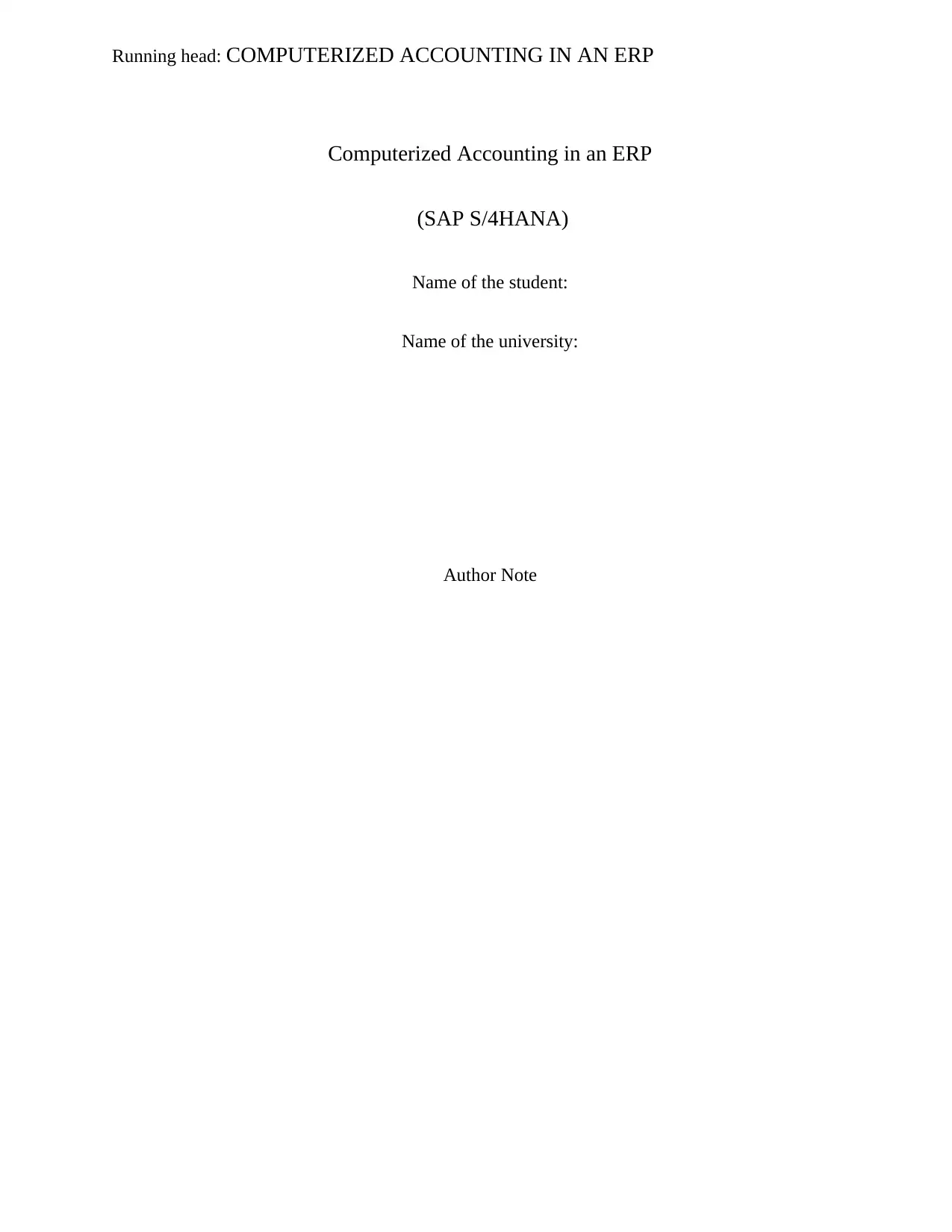
Running head: COMPUTERIZED ACCOUNTING IN AN ERP
Computerized Accounting in an ERP
(SAP S/4HANA)
Name of the student:
Name of the university:
Author Note
Computerized Accounting in an ERP
(SAP S/4HANA)
Name of the student:
Name of the university:
Author Note
Secure Best Marks with AI Grader
Need help grading? Try our AI Grader for instant feedback on your assignments.
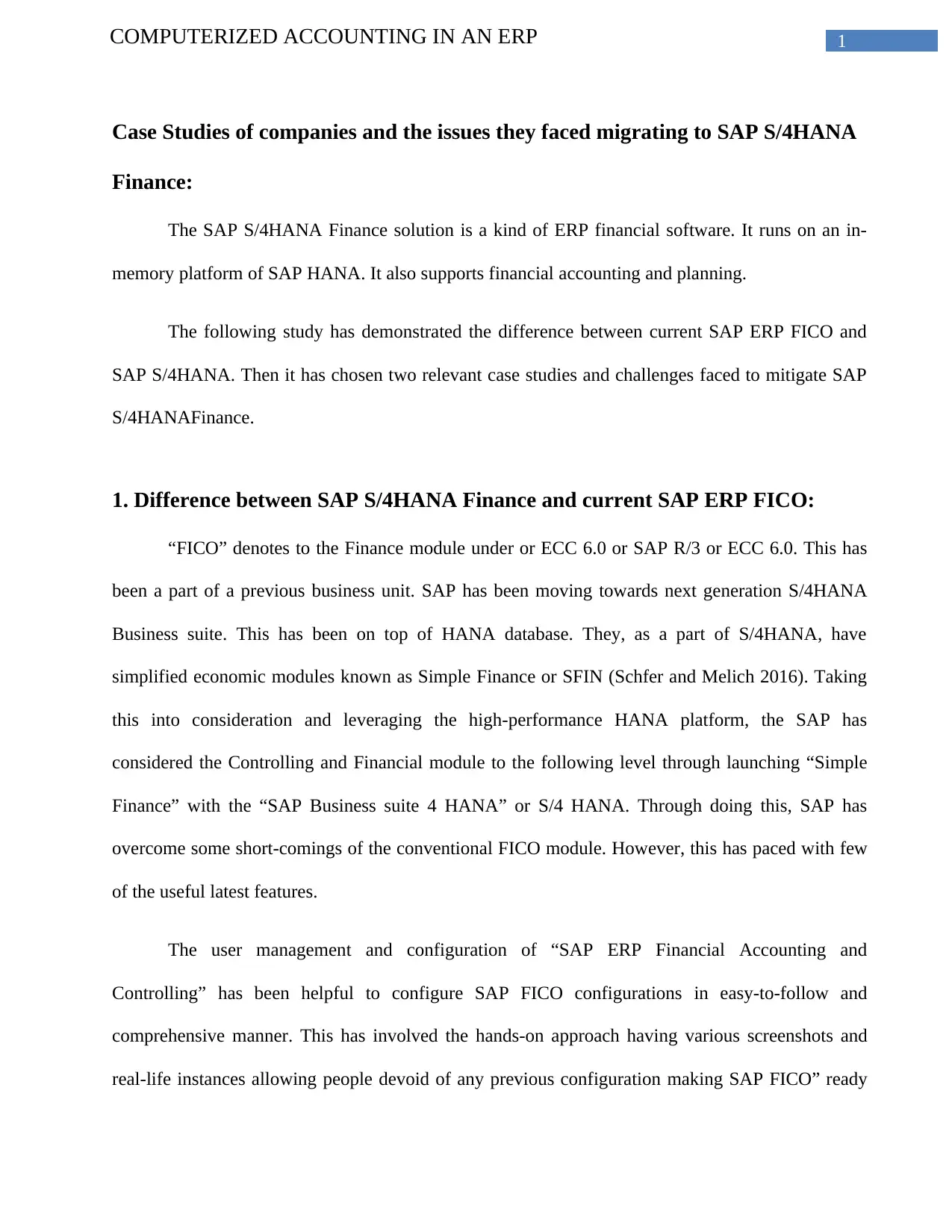
1COMPUTERIZED ACCOUNTING IN AN ERP
Case Studies of companies and the issues they faced migrating to SAP S/4HANA
Finance:
The SAP S/4HANA Finance solution is a kind of ERP financial software. It runs on an in-
memory platform of SAP HANA. It also supports financial accounting and planning.
The following study has demonstrated the difference between current SAP ERP FICO and
SAP S/4HANA. Then it has chosen two relevant case studies and challenges faced to mitigate SAP
S/4HANAFinance.
1. Difference between SAP S/4HANA Finance and current SAP ERP FICO:
“FICO” denotes to the Finance module under or ECC 6.0 or SAP R/3 or ECC 6.0. This has
been a part of a previous business unit. SAP has been moving towards next generation S/4HANA
Business suite. This has been on top of HANA database. They, as a part of S/4HANA, have
simplified economic modules known as Simple Finance or SFIN (Schfer and Melich 2016). Taking
this into consideration and leveraging the high-performance HANA platform, the SAP has
considered the Controlling and Financial module to the following level through launching “Simple
Finance” with the “SAP Business suite 4 HANA” or S/4 HANA. Through doing this, SAP has
overcome some short-comings of the conventional FICO module. However, this has paced with few
of the useful latest features.
The user management and configuration of “SAP ERP Financial Accounting and
Controlling” has been helpful to configure SAP FICO configurations in easy-to-follow and
comprehensive manner. This has involved the hands-on approach having various screenshots and
real-life instances allowing people devoid of any previous configuration making SAP FICO” ready
Case Studies of companies and the issues they faced migrating to SAP S/4HANA
Finance:
The SAP S/4HANA Finance solution is a kind of ERP financial software. It runs on an in-
memory platform of SAP HANA. It also supports financial accounting and planning.
The following study has demonstrated the difference between current SAP ERP FICO and
SAP S/4HANA. Then it has chosen two relevant case studies and challenges faced to mitigate SAP
S/4HANAFinance.
1. Difference between SAP S/4HANA Finance and current SAP ERP FICO:
“FICO” denotes to the Finance module under or ECC 6.0 or SAP R/3 or ECC 6.0. This has
been a part of a previous business unit. SAP has been moving towards next generation S/4HANA
Business suite. This has been on top of HANA database. They, as a part of S/4HANA, have
simplified economic modules known as Simple Finance or SFIN (Schfer and Melich 2016). Taking
this into consideration and leveraging the high-performance HANA platform, the SAP has
considered the Controlling and Financial module to the following level through launching “Simple
Finance” with the “SAP Business suite 4 HANA” or S/4 HANA. Through doing this, SAP has
overcome some short-comings of the conventional FICO module. However, this has paced with few
of the useful latest features.
The user management and configuration of “SAP ERP Financial Accounting and
Controlling” has been helpful to configure SAP FICO configurations in easy-to-follow and
comprehensive manner. This has involved the hands-on approach having various screenshots and
real-life instances allowing people devoid of any previous configuration making SAP FICO” ready
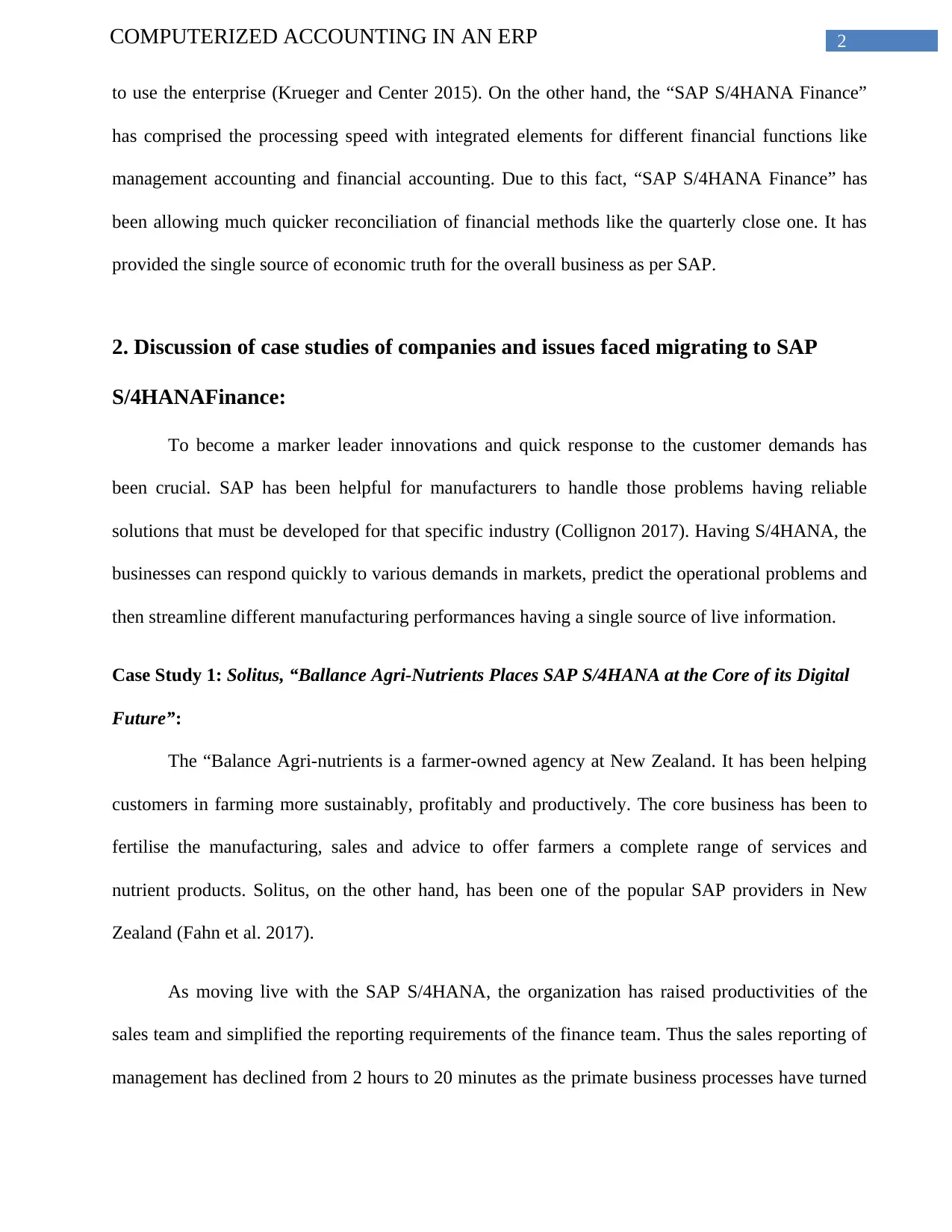
2COMPUTERIZED ACCOUNTING IN AN ERP
to use the enterprise (Krueger and Center 2015). On the other hand, the “SAP S/4HANA Finance”
has comprised the processing speed with integrated elements for different financial functions like
management accounting and financial accounting. Due to this fact, “SAP S/4HANA Finance” has
been allowing much quicker reconciliation of financial methods like the quarterly close one. It has
provided the single source of economic truth for the overall business as per SAP.
2. Discussion of case studies of companies and issues faced migrating to SAP
S/4HANAFinance:
To become a marker leader innovations and quick response to the customer demands has
been crucial. SAP has been helpful for manufacturers to handle those problems having reliable
solutions that must be developed for that specific industry (Collignon 2017). Having S/4HANA, the
businesses can respond quickly to various demands in markets, predict the operational problems and
then streamline different manufacturing performances having a single source of live information.
Case Study 1: Solitus, “Ballance Agri-Nutrients Places SAP S/4HANA at the Core of its Digital
Future”:
The “Balance Agri-nutrients is a farmer-owned agency at New Zealand. It has been helping
customers in farming more sustainably, profitably and productively. The core business has been to
fertilise the manufacturing, sales and advice to offer farmers a complete range of services and
nutrient products. Solitus, on the other hand, has been one of the popular SAP providers in New
Zealand (Fahn et al. 2017).
As moving live with the SAP S/4HANA, the organization has raised productivities of the
sales team and simplified the reporting requirements of the finance team. Thus the sales reporting of
management has declined from 2 hours to 20 minutes as the primate business processes have turned
to use the enterprise (Krueger and Center 2015). On the other hand, the “SAP S/4HANA Finance”
has comprised the processing speed with integrated elements for different financial functions like
management accounting and financial accounting. Due to this fact, “SAP S/4HANA Finance” has
been allowing much quicker reconciliation of financial methods like the quarterly close one. It has
provided the single source of economic truth for the overall business as per SAP.
2. Discussion of case studies of companies and issues faced migrating to SAP
S/4HANAFinance:
To become a marker leader innovations and quick response to the customer demands has
been crucial. SAP has been helpful for manufacturers to handle those problems having reliable
solutions that must be developed for that specific industry (Collignon 2017). Having S/4HANA, the
businesses can respond quickly to various demands in markets, predict the operational problems and
then streamline different manufacturing performances having a single source of live information.
Case Study 1: Solitus, “Ballance Agri-Nutrients Places SAP S/4HANA at the Core of its Digital
Future”:
The “Balance Agri-nutrients is a farmer-owned agency at New Zealand. It has been helping
customers in farming more sustainably, profitably and productively. The core business has been to
fertilise the manufacturing, sales and advice to offer farmers a complete range of services and
nutrient products. Solitus, on the other hand, has been one of the popular SAP providers in New
Zealand (Fahn et al. 2017).
As moving live with the SAP S/4HANA, the organization has raised productivities of the
sales team and simplified the reporting requirements of the finance team. Thus the sales reporting of
management has declined from 2 hours to 20 minutes as the primate business processes have turned
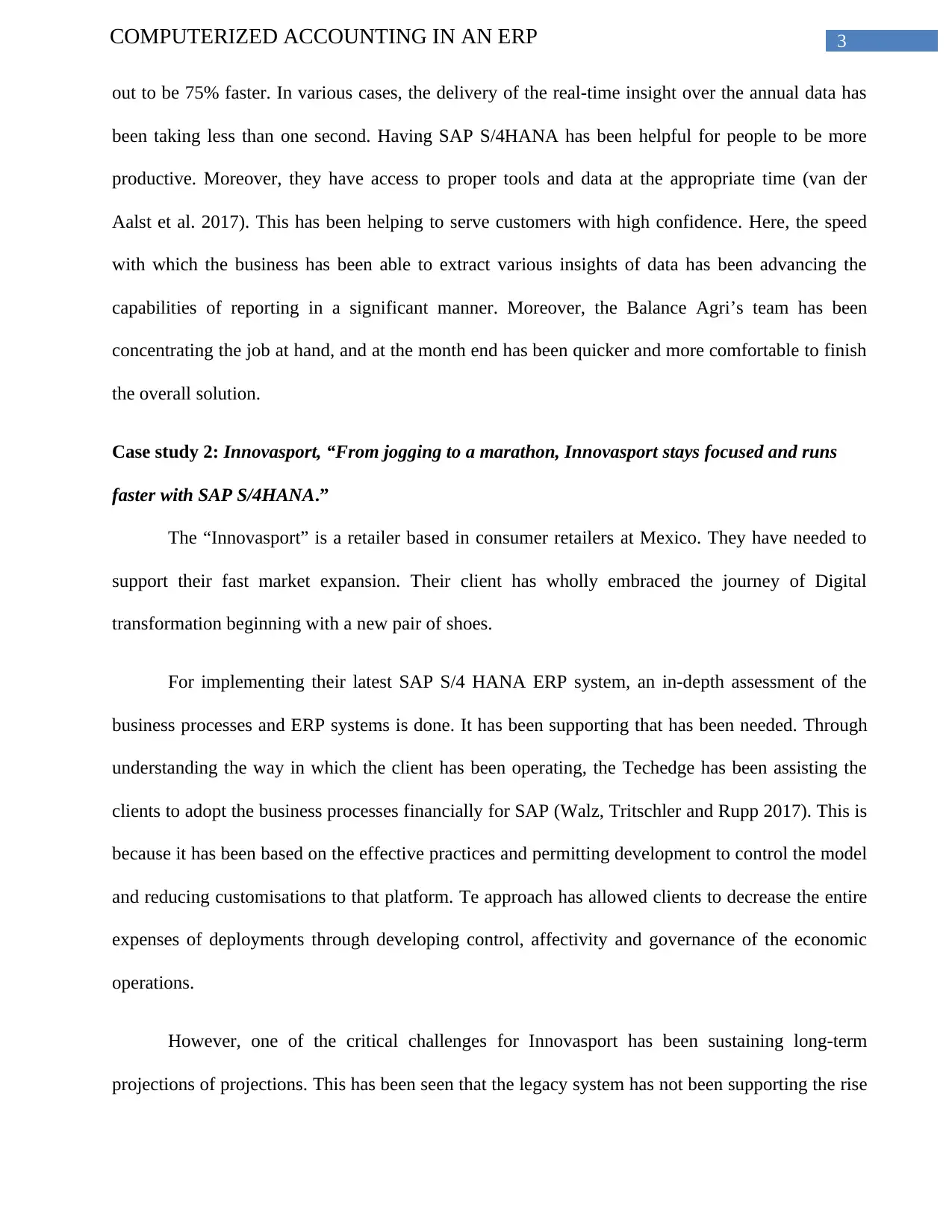
3COMPUTERIZED ACCOUNTING IN AN ERP
out to be 75% faster. In various cases, the delivery of the real-time insight over the annual data has
been taking less than one second. Having SAP S/4HANA has been helpful for people to be more
productive. Moreover, they have access to proper tools and data at the appropriate time (van der
Aalst et al. 2017). This has been helping to serve customers with high confidence. Here, the speed
with which the business has been able to extract various insights of data has been advancing the
capabilities of reporting in a significant manner. Moreover, the Balance Agri’s team has been
concentrating the job at hand, and at the month end has been quicker and more comfortable to finish
the overall solution.
Case study 2: Innovasport, “From jogging to a marathon, Innovasport stays focused and runs
faster with SAP S/4HANA.”
The “Innovasport” is a retailer based in consumer retailers at Mexico. They have needed to
support their fast market expansion. Their client has wholly embraced the journey of Digital
transformation beginning with a new pair of shoes.
For implementing their latest SAP S/4 HANA ERP system, an in-depth assessment of the
business processes and ERP systems is done. It has been supporting that has been needed. Through
understanding the way in which the client has been operating, the Techedge has been assisting the
clients to adopt the business processes financially for SAP (Walz, Tritschler and Rupp 2017). This is
because it has been based on the effective practices and permitting development to control the model
and reducing customisations to that platform. Te approach has allowed clients to decrease the entire
expenses of deployments through developing control, affectivity and governance of the economic
operations.
However, one of the critical challenges for Innovasport has been sustaining long-term
projections of projections. This has been seen that the legacy system has not been supporting the rise
out to be 75% faster. In various cases, the delivery of the real-time insight over the annual data has
been taking less than one second. Having SAP S/4HANA has been helpful for people to be more
productive. Moreover, they have access to proper tools and data at the appropriate time (van der
Aalst et al. 2017). This has been helping to serve customers with high confidence. Here, the speed
with which the business has been able to extract various insights of data has been advancing the
capabilities of reporting in a significant manner. Moreover, the Balance Agri’s team has been
concentrating the job at hand, and at the month end has been quicker and more comfortable to finish
the overall solution.
Case study 2: Innovasport, “From jogging to a marathon, Innovasport stays focused and runs
faster with SAP S/4HANA.”
The “Innovasport” is a retailer based in consumer retailers at Mexico. They have needed to
support their fast market expansion. Their client has wholly embraced the journey of Digital
transformation beginning with a new pair of shoes.
For implementing their latest SAP S/4 HANA ERP system, an in-depth assessment of the
business processes and ERP systems is done. It has been supporting that has been needed. Through
understanding the way in which the client has been operating, the Techedge has been assisting the
clients to adopt the business processes financially for SAP (Walz, Tritschler and Rupp 2017). This is
because it has been based on the effective practices and permitting development to control the model
and reducing customisations to that platform. Te approach has allowed clients to decrease the entire
expenses of deployments through developing control, affectivity and governance of the economic
operations.
However, one of the critical challenges for Innovasport has been sustaining long-term
projections of projections. This has been seen that the legacy system has not been supporting the rise
Secure Best Marks with AI Grader
Need help grading? Try our AI Grader for instant feedback on your assignments.
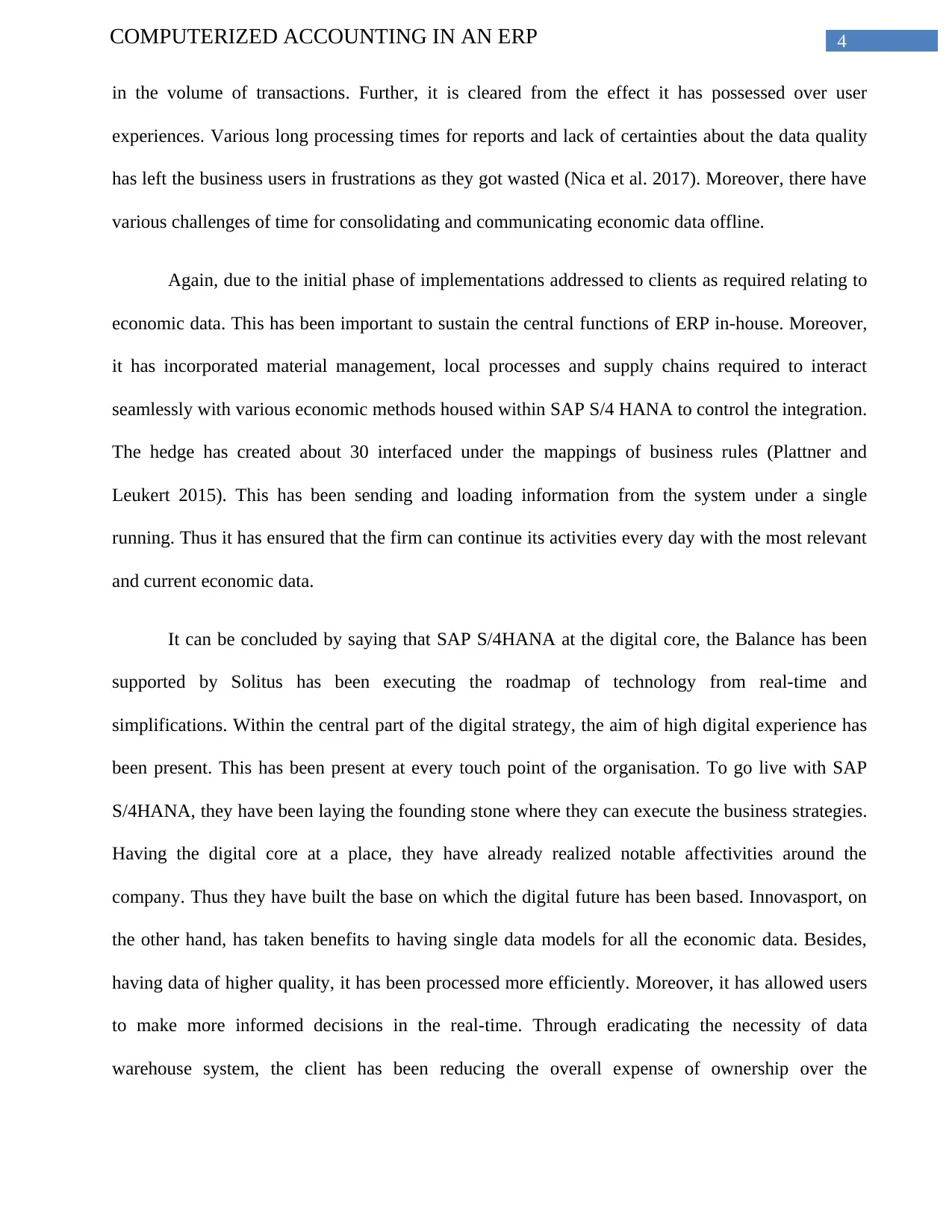
4COMPUTERIZED ACCOUNTING IN AN ERP
in the volume of transactions. Further, it is cleared from the effect it has possessed over user
experiences. Various long processing times for reports and lack of certainties about the data quality
has left the business users in frustrations as they got wasted (Nica et al. 2017). Moreover, there have
various challenges of time for consolidating and communicating economic data offline.
Again, due to the initial phase of implementations addressed to clients as required relating to
economic data. This has been important to sustain the central functions of ERP in-house. Moreover,
it has incorporated material management, local processes and supply chains required to interact
seamlessly with various economic methods housed within SAP S/4 HANA to control the integration.
The hedge has created about 30 interfaced under the mappings of business rules (Plattner and
Leukert 2015). This has been sending and loading information from the system under a single
running. Thus it has ensured that the firm can continue its activities every day with the most relevant
and current economic data.
It can be concluded by saying that SAP S/4HANA at the digital core, the Balance has been
supported by Solitus has been executing the roadmap of technology from real-time and
simplifications. Within the central part of the digital strategy, the aim of high digital experience has
been present. This has been present at every touch point of the organisation. To go live with SAP
S/4HANA, they have been laying the founding stone where they can execute the business strategies.
Having the digital core at a place, they have already realized notable affectivities around the
company. Thus they have built the base on which the digital future has been based. Innovasport, on
the other hand, has taken benefits to having single data models for all the economic data. Besides,
having data of higher quality, it has been processed more efficiently. Moreover, it has allowed users
to make more informed decisions in the real-time. Through eradicating the necessity of data
warehouse system, the client has been reducing the overall expense of ownership over the
in the volume of transactions. Further, it is cleared from the effect it has possessed over user
experiences. Various long processing times for reports and lack of certainties about the data quality
has left the business users in frustrations as they got wasted (Nica et al. 2017). Moreover, there have
various challenges of time for consolidating and communicating economic data offline.
Again, due to the initial phase of implementations addressed to clients as required relating to
economic data. This has been important to sustain the central functions of ERP in-house. Moreover,
it has incorporated material management, local processes and supply chains required to interact
seamlessly with various economic methods housed within SAP S/4 HANA to control the integration.
The hedge has created about 30 interfaced under the mappings of business rules (Plattner and
Leukert 2015). This has been sending and loading information from the system under a single
running. Thus it has ensured that the firm can continue its activities every day with the most relevant
and current economic data.
It can be concluded by saying that SAP S/4HANA at the digital core, the Balance has been
supported by Solitus has been executing the roadmap of technology from real-time and
simplifications. Within the central part of the digital strategy, the aim of high digital experience has
been present. This has been present at every touch point of the organisation. To go live with SAP
S/4HANA, they have been laying the founding stone where they can execute the business strategies.
Having the digital core at a place, they have already realized notable affectivities around the
company. Thus they have built the base on which the digital future has been based. Innovasport, on
the other hand, has taken benefits to having single data models for all the economic data. Besides,
having data of higher quality, it has been processed more efficiently. Moreover, it has allowed users
to make more informed decisions in the real-time. Through eradicating the necessity of data
warehouse system, the client has been reducing the overall expense of ownership over the
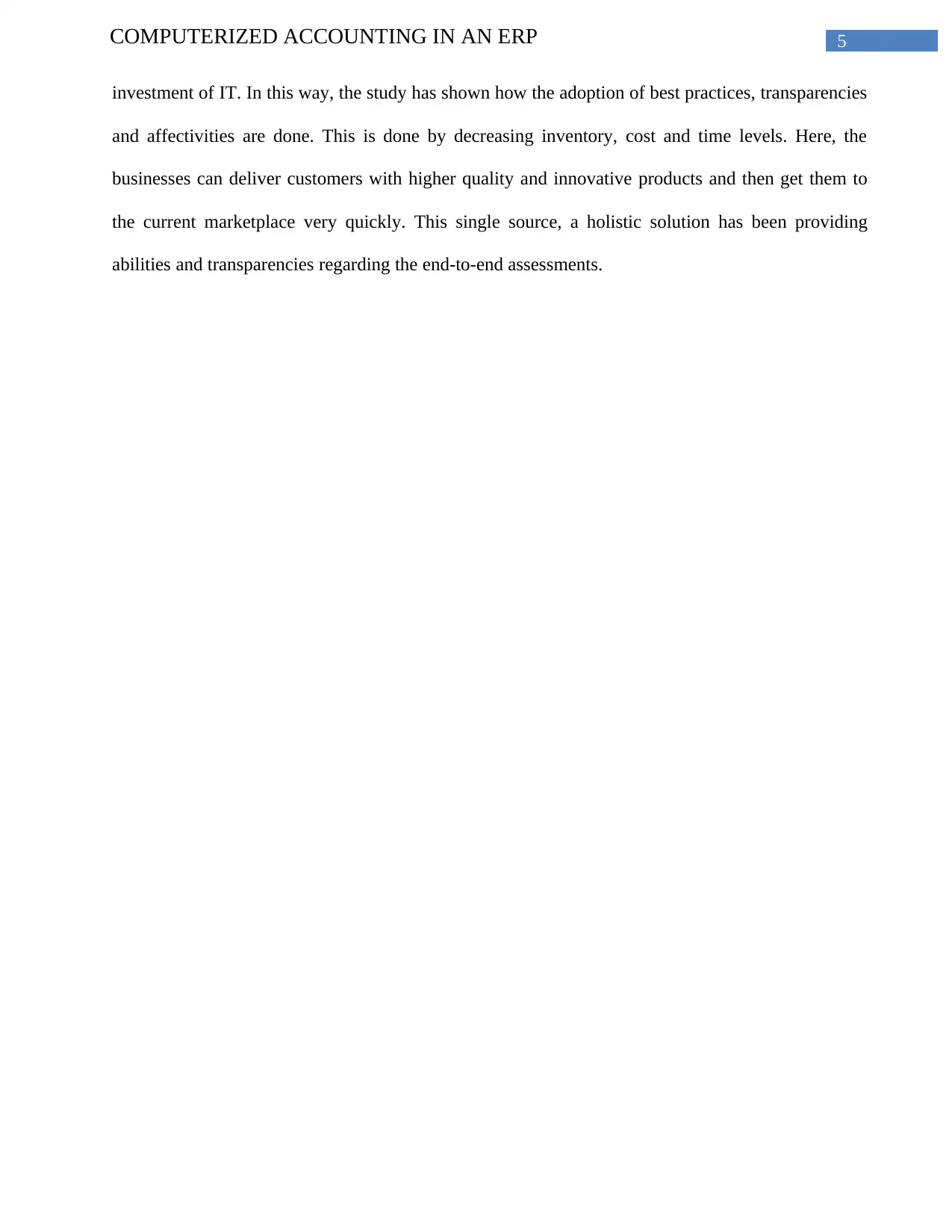
5COMPUTERIZED ACCOUNTING IN AN ERP
investment of IT. In this way, the study has shown how the adoption of best practices, transparencies
and affectivities are done. This is done by decreasing inventory, cost and time levels. Here, the
businesses can deliver customers with higher quality and innovative products and then get them to
the current marketplace very quickly. This single source, a holistic solution has been providing
abilities and transparencies regarding the end-to-end assessments.
investment of IT. In this way, the study has shown how the adoption of best practices, transparencies
and affectivities are done. This is done by decreasing inventory, cost and time levels. Here, the
businesses can deliver customers with higher quality and innovative products and then get them to
the current marketplace very quickly. This single source, a holistic solution has been providing
abilities and transparencies regarding the end-to-end assessments.
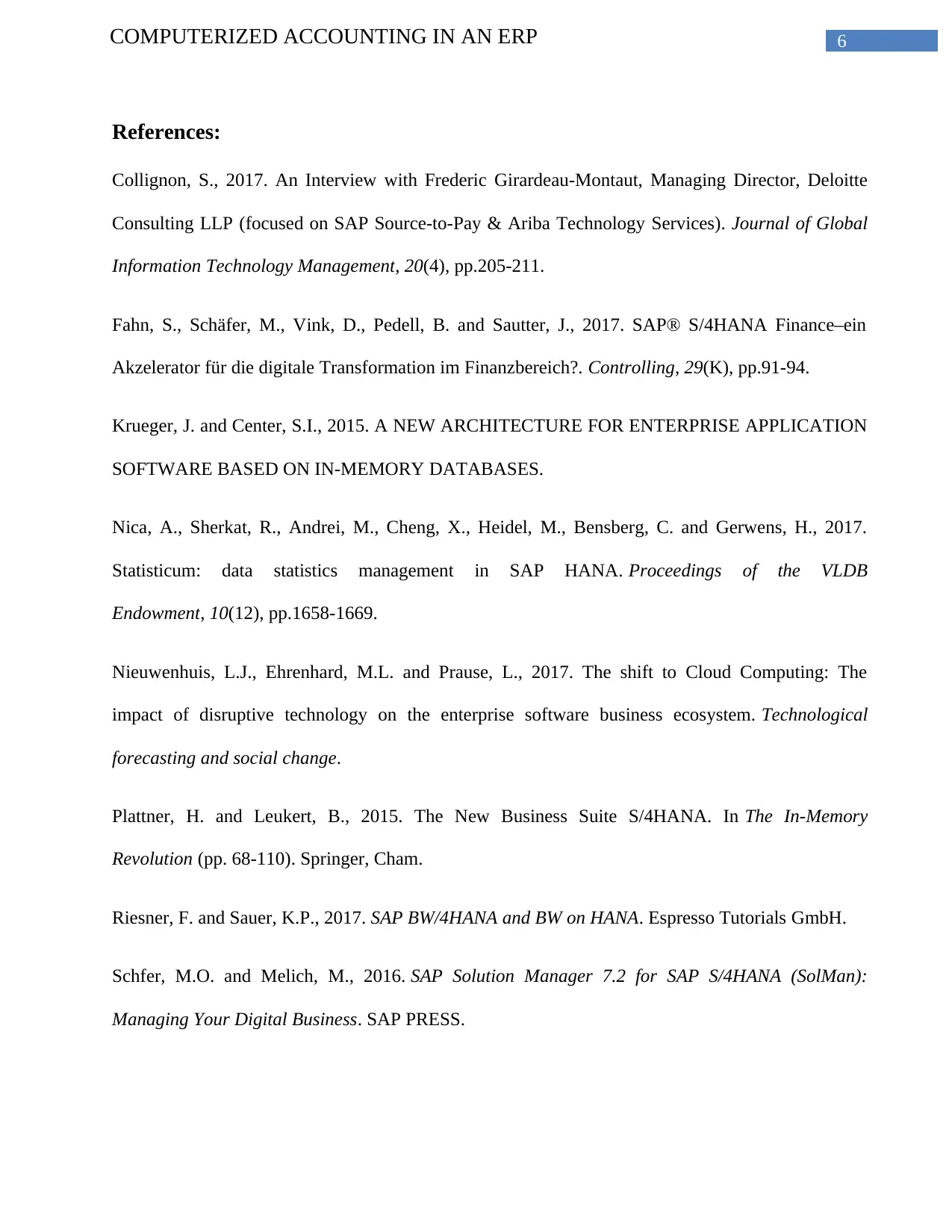
6COMPUTERIZED ACCOUNTING IN AN ERP
References:
Collignon, S., 2017. An Interview with Frederic Girardeau-Montaut, Managing Director, Deloitte
Consulting LLP (focused on SAP Source-to-Pay & Ariba Technology Services). Journal of Global
Information Technology Management, 20(4), pp.205-211.
Fahn, S., Schäfer, M., Vink, D., Pedell, B. and Sautter, J., 2017. SAP® S/4HANA Finance–ein
Akzelerator für die digitale Transformation im Finanzbereich?. Controlling, 29(K), pp.91-94.
Krueger, J. and Center, S.I., 2015. A NEW ARCHITECTURE FOR ENTERPRISE APPLICATION
SOFTWARE BASED ON IN-MEMORY DATABASES.
Nica, A., Sherkat, R., Andrei, M., Cheng, X., Heidel, M., Bensberg, C. and Gerwens, H., 2017.
Statisticum: data statistics management in SAP HANA. Proceedings of the VLDB
Endowment, 10(12), pp.1658-1669.
Nieuwenhuis, L.J., Ehrenhard, M.L. and Prause, L., 2017. The shift to Cloud Computing: The
impact of disruptive technology on the enterprise software business ecosystem. Technological
forecasting and social change.
Plattner, H. and Leukert, B., 2015. The New Business Suite S/4HANA. In The In-Memory
Revolution (pp. 68-110). Springer, Cham.
Riesner, F. and Sauer, K.P., 2017. SAP BW/4HANA and BW on HANA. Espresso Tutorials GmbH.
Schfer, M.O. and Melich, M., 2016. SAP Solution Manager 7.2 for SAP S/4HANA (SolMan):
Managing Your Digital Business. SAP PRESS.
References:
Collignon, S., 2017. An Interview with Frederic Girardeau-Montaut, Managing Director, Deloitte
Consulting LLP (focused on SAP Source-to-Pay & Ariba Technology Services). Journal of Global
Information Technology Management, 20(4), pp.205-211.
Fahn, S., Schäfer, M., Vink, D., Pedell, B. and Sautter, J., 2017. SAP® S/4HANA Finance–ein
Akzelerator für die digitale Transformation im Finanzbereich?. Controlling, 29(K), pp.91-94.
Krueger, J. and Center, S.I., 2015. A NEW ARCHITECTURE FOR ENTERPRISE APPLICATION
SOFTWARE BASED ON IN-MEMORY DATABASES.
Nica, A., Sherkat, R., Andrei, M., Cheng, X., Heidel, M., Bensberg, C. and Gerwens, H., 2017.
Statisticum: data statistics management in SAP HANA. Proceedings of the VLDB
Endowment, 10(12), pp.1658-1669.
Nieuwenhuis, L.J., Ehrenhard, M.L. and Prause, L., 2017. The shift to Cloud Computing: The
impact of disruptive technology on the enterprise software business ecosystem. Technological
forecasting and social change.
Plattner, H. and Leukert, B., 2015. The New Business Suite S/4HANA. In The In-Memory
Revolution (pp. 68-110). Springer, Cham.
Riesner, F. and Sauer, K.P., 2017. SAP BW/4HANA and BW on HANA. Espresso Tutorials GmbH.
Schfer, M.O. and Melich, M., 2016. SAP Solution Manager 7.2 for SAP S/4HANA (SolMan):
Managing Your Digital Business. SAP PRESS.
Paraphrase This Document
Need a fresh take? Get an instant paraphrase of this document with our AI Paraphraser
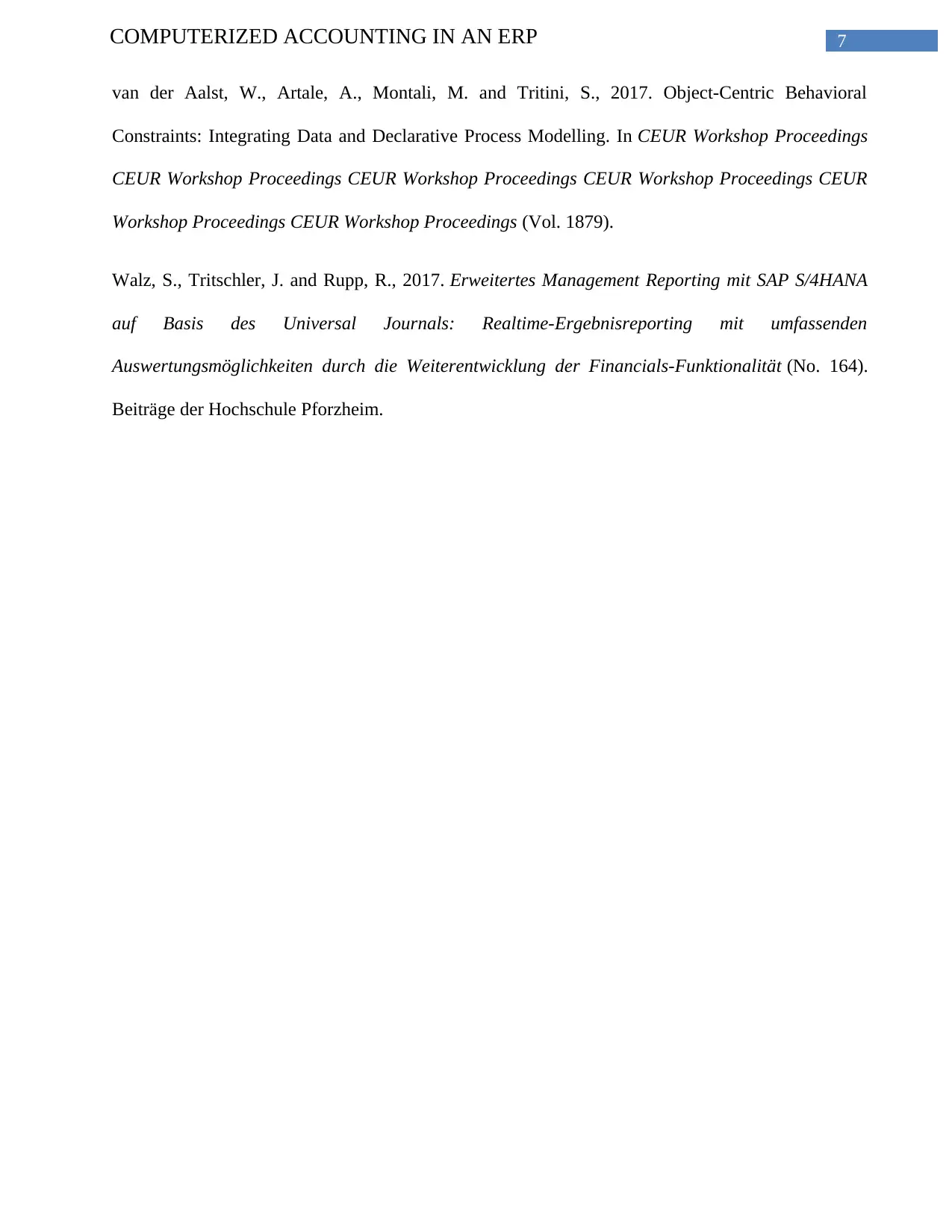
7COMPUTERIZED ACCOUNTING IN AN ERP
van der Aalst, W., Artale, A., Montali, M. and Tritini, S., 2017. Object-Centric Behavioral
Constraints: Integrating Data and Declarative Process Modelling. In CEUR Workshop Proceedings
CEUR Workshop Proceedings CEUR Workshop Proceedings CEUR Workshop Proceedings CEUR
Workshop Proceedings CEUR Workshop Proceedings (Vol. 1879).
Walz, S., Tritschler, J. and Rupp, R., 2017. Erweitertes Management Reporting mit SAP S/4HANA
auf Basis des Universal Journals: Realtime-Ergebnisreporting mit umfassenden
Auswertungsmöglichkeiten durch die Weiterentwicklung der Financials-Funktionalität (No. 164).
Beiträge der Hochschule Pforzheim.
van der Aalst, W., Artale, A., Montali, M. and Tritini, S., 2017. Object-Centric Behavioral
Constraints: Integrating Data and Declarative Process Modelling. In CEUR Workshop Proceedings
CEUR Workshop Proceedings CEUR Workshop Proceedings CEUR Workshop Proceedings CEUR
Workshop Proceedings CEUR Workshop Proceedings (Vol. 1879).
Walz, S., Tritschler, J. and Rupp, R., 2017. Erweitertes Management Reporting mit SAP S/4HANA
auf Basis des Universal Journals: Realtime-Ergebnisreporting mit umfassenden
Auswertungsmöglichkeiten durch die Weiterentwicklung der Financials-Funktionalität (No. 164).
Beiträge der Hochschule Pforzheim.
1 out of 8
Related Documents
Your All-in-One AI-Powered Toolkit for Academic Success.
+13062052269
info@desklib.com
Available 24*7 on WhatsApp / Email
![[object Object]](/_next/static/media/star-bottom.7253800d.svg)
Unlock your academic potential
© 2024 | Zucol Services PVT LTD | All rights reserved.





